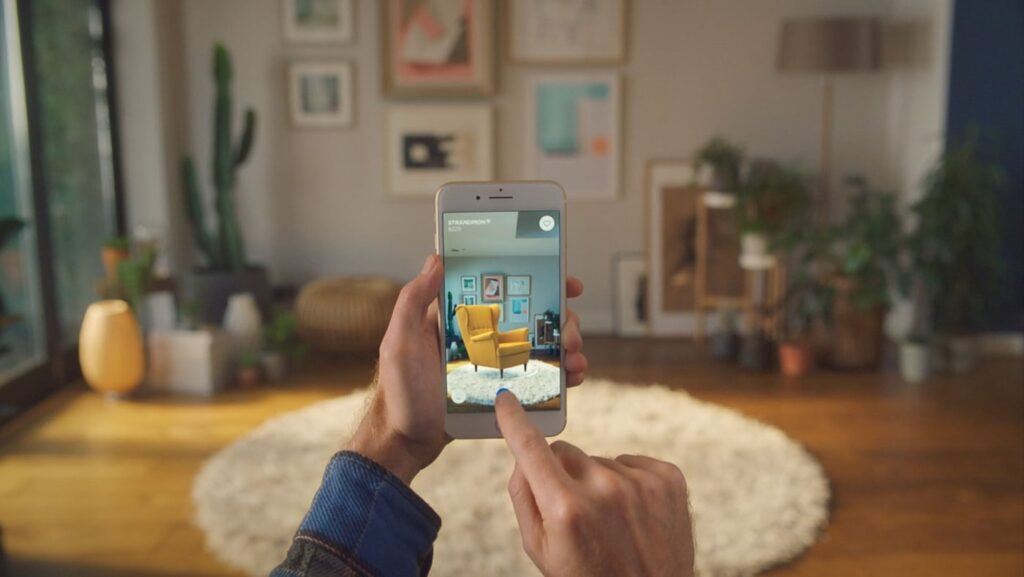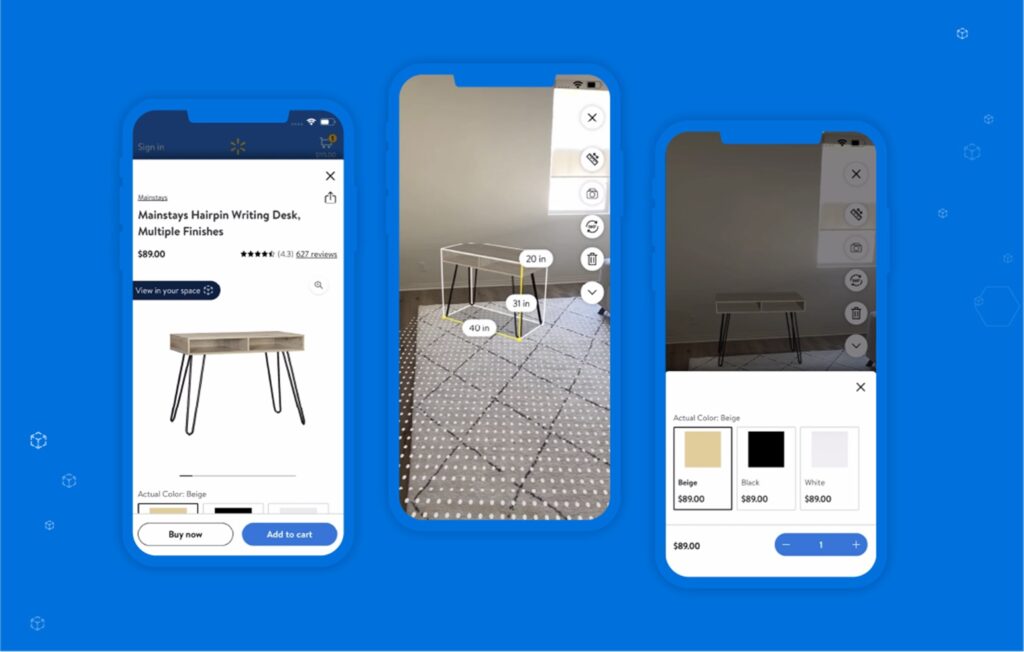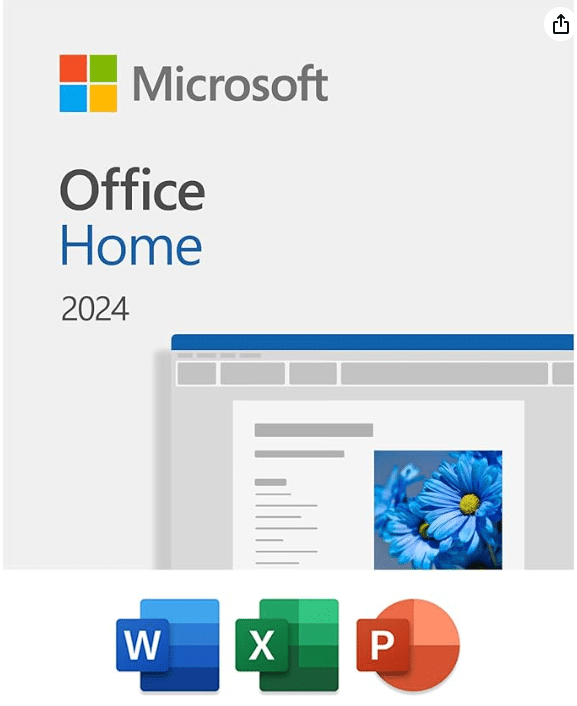
Augmented Reality (AR)—it’s not science fiction; it’s science fact. Imagine overlaying digital information onto the physical world you see. AR bridges the gap between tangible and digital, enhancing our reality rather than replacing it. According to recent statistics, the global AR market is projected to reach $570.79699 billion by 2032, with a compound annual growth rate (CAGR) of 41.50% from 2024 to 2032. And where does this magic unfold most vividly? In the heart of retail spaces.
Let me share a secret: AR isn’t just for tech enthusiasts or early adopters. It’s for you—the curious shopper who wonders what lies beyond the ordinary. It’s for the retailer who dreams of turning their ordinary store shelves into exciting places of exploration.
So fasten your seatbelt (or your AR headset?) because we’re about to explore the beauty, potential, and sheer joy of Augmented Reality in Retail.
Table of Contents
What is Augmented Reality in Retail?
Defining Augmented Reality
Before we dive into what is Augmented reality in Retails let us first understand What is Augmented reality. Augmented Reality (AR) is a revolutionary technology that superimposes digital information, such as images, videos, or data, onto the physical world in real-time.
Unlike virtual Reality, which immerses users in a completely virtual environment, AR enhances the real world by adding augmented and virtual reality elements. AR transforms how consumers interact with products and brands in the retail sector, offering immersive and interactive shopping experiences.
If you want to understand Augmented Reality more in detail you may go through our article Everything You Need to Know about Augmented Reality
Augmented Reality in Retail
In an era where consumer expectations are rapidly evolving, the retail landscape finds itself at a crossroads. To thrive in this dynamic environment, innovation isn’t just an option; it’s a necessity. One such innovation that’s reshaping the retail experience is augmented Reality (AR).
Customer experience reigns supreme in today’s retail arena. In this fiercely competitive market, businesses must go beyond merely selling products and create memorable experiences that resonate with consumers.
Augmented Reality, often called AR, is a cutting-edge technology that blurs the line between the digital and physical worlds. Unlike virtual Reality, which immerses users in entirely simulated environments, AR enriches real-world surroundings by overlaying digital content. Picture trying on virtual clothes without stepping foot in a fitting room or visualizing furniture in your living room before making a purchase. That’s the magic of augmented Reality.
The applications of AR in retail are as diverse as they are revolutionary. In the online realm, customers can use AR to preview products in real-world environments through smartphones or other devices. Meanwhile, AR-enhanced displays can provide interactive experiences in physical stores, guiding shoppers through product features or offering personalized recommendations.
The impact of augmented Reality on consumer habits and the purchasing process cannot be overstated. By bridging the gap between online and offline shopping experiences, AR fosters greater engagement and empowers consumers to make more informed decisions. This not only enhances customer satisfaction but also drives sales and cultivates brand loyalty.
Behind the seamless integration of digital content into the real world lies a sophisticated blend of technologies. Augmented Reality relies on computer vision, spatial mapping, and advanced algorithms to accurately overlay digital elements onto physical environments. Moreover, the proliferation of high-speed mobile networks and powerful mobile devices has made AR more accessible.
Augmented Reality represents more than a technological novelty; it’s a game-changer for the retail industry. By embracing AR, retailers can unlock new realms of possibility, elevating the shopping experience to unprecedented heights. As we look to the future, augmented reality stands poised to lead the charge in shaping the next generation of retail innovation.
The Problem with Traditional Retail: A Reality Check
In the quiet corners of brick-and-mortar stores, a silent struggle unfolds.
Let’s peel back the layers and examine the cracks in the traditional retail system:
- Limited Space: Physical stores have finite space. They can only magically expand to accommodate some product variant, color option, or size permutation. So, choices are curtailed, and shoppers often settle for what’s available rather than what’s ideal.
- Analog Engagement: The interaction between the shopper and the product remains analog. You pick up a shirt, feel the fabric, squint at the price tag, and hope it fits. But where’s the magic? Where’s the thrill of discovery?
- Limited Data Insights: Traditional retail stores may need more access to real-time data insights and analytics, hindering their ability to understand consumer behavior and preferences. With access to actionable data, retailers may be able to tailor their offerings to meet the evolving needs and preferences of their target audience.
- Resistance to Change: Traditional retailers may need help adapting to changing consumer preferences and technological advancements, including adopting augmented Reality. With a willingness to embrace innovation and change, traditional retailers can stay caught up in an increasingly digital retail landscape.
Customer Expectations
Customer expectations have evolved faster than a chameleon on a shifting landscape. Here’s what they demand:
- Hyper-Personalization: “Know me,” they whisper to retailers. They want tailored recommendations based on their browsing history and preferences.
- Interactive Adventures: Shoppers crave experiences, not just transactions. They want to try that dress virtually, see how the couch fits in their living room, and visualize the blender blending (without making a mess).
How Augmented Reality Transforms Retail
Augmented Reality (AR) is revolutionizing the retail industry by offering immersive and interactive experiences that enhance consumers’ shopping journeys.
Here are five real-life examples showcasing how AR is transforming the retail landscape:
1. Sephora Immersive 'Try Before You Buy' Makeup Experience with AR
Initial Challenge:
Choosing the right makeup products can be overwhelming, especially when shopping online. It’s hard to know how a lipstick or eyeshadow will look on your skin without trying it on first. Finding personalized beauty recommendations tailored to your skin type and preferences can also be challenging in-store.
AR Solution:
Sephora has integrated AR technology into its app and in-store experience to address these challenges. Through virtual try-ons and personalized beauty recommendations, customers can now experiment with different makeup looks and receive tailored product suggestions.
Customer Satisfaction:
Imagine you’re browsing for a new lipstick shade online. Sephora’s AR-powered virtual try-on feature lets you see how each shade looks on your lips in real time using your phone’s camera. This interactive experience eliminates the guesswork and allows you to choose the perfect shade for your look confidently.
When you visit a Sephora store, their beauty advisors armed with iPads and AR-powered apps take personalized recommendations to the next level. After a quick scan of your skin tone and facial features, they guide you through a personalized beauty journey, recommending products curated just for you. This personalized approach ensures you find products that enhance your features and align with your preferences and skincare concerns.
Sephora’s use of AR technology transforms the way customers shop for beauty products, offering immersive and personalized experiences that enhance satisfaction and confidence in their purchases.
2. IKEA Virtual 'Try Before You Build' Furniture Shopping with AR
Initial Challenge:
Buying furniture can be daunting, especially when you’re unsure if it will fit or look right in your space. Traditional shopping experiences often involve imagining how a piece will look in your home based on measurements and showroom displays, leading to uncertainty and hesitation before purchasing. Additionally, assembling furniture can be frustrating and time-consuming, especially if the instructions are unclear or you’re not accustomed to DIY tasks.
AR Solution:
To address these challenges, IKEA has implemented augmented Reality (AR) technology into its shopping experience. With the IKEA AR app, customers can visualize furniture in their own space before buying and receive interactive assembly instructions, revolutionizing how people shop for and assemble furniture.
Customer Satisfaction:
Imagine you’re shopping for a new sofa at IKEA. Instead of guessing how it will look in your living room, you simply pull out your smartphone and open the IKEA AR app. With a few taps, you can virtually place different sofas in your space, adjusting sizes and styles until you find the perfect fit. This immersive experience eliminates uncertainty and allows you to confidently choose the right piece for your home.
When assembling your furniture, the AR app continues to simplify the process. Instead of wrestling with confusing paper instructions, you follow clear, step-by-step guidance directly on your device. Animated instructions overlay the physical pieces, showing you how to assemble them easily. This interactive approach makes assembling furniture a breeze, even for those with little DIY experience.
In essence, IKEA’s integration of AR technology addresses the pain points of traditional furniture shopping and assembly, providing customers with a seamless and enjoyable experience from selection to setup. With the power of AR, customers can make informed decisions, visualize their purchases in real-life settings, and assemble furniture with confidence, ultimately leading to greater satisfaction and peace of mind.
3. Lego Interactive Building with AR
Initial Challenge:
Shopping for toys, especially building sets like Legos, often involves imagining how the final product will look and assembling it based on traditional paper instructions. This process can be challenging and may not fully engage customers, especially children, in the building experience.
AR Solution:
Lego has introduced AR-powered shopping experiences and interactive build instructions through their AR app.
Customer Satisfaction:
Imagine stepping into a Lego store with your kids and being greeted by an AR-powered adventure waiting to unfold. With the Lego AR Explorer app, you embark on a treasure hunt throughout the store, searching for hidden digital clues and virtual Lego creations. This gamified approach transforms the shopping experience into a playful quest that captivates the whole family, enhancing engagement and enjoyment.
Once you’re home with a new Lego set, you can use the Lego AR Build app to follow interactive build instructions. Instead of flipping through a paper booklet, animated instructions materialize on your device’s screen, guiding you through each assembly process step with clarity and excitement. AR overlays highlight key connections and demonstrate advanced building techniques, making the building experience more engaging and educational.
Lego’s integration of AR technology enhances the shopping and building experience, offering customers gamified adventures and interactive instructions that foster creativity, engagement, and satisfaction.
4. Walmart Shopping Made Easy with AR Navigation and Product Info
Initial Challenge:
Navigating a large retail store like Walmart can be time-consuming and overwhelming, especially when searching for specific products. Additionally, accessing detailed product information while shopping in-store can be challenging, leading to uncertainty about product features and quality.
AR Solution:
Walmart has implemented AR technology to address these challenges, offering AR-powered navigation in stores and enhanced product information displays through their app.
Customer Satisfaction:
Picture yourself walking into a Walmart store with a shopping list in hand. Instead of wandering through aisles, you open the Walmart AR Navigation app on your smartphone. Digital arrows and signs overlaid onto the store layout guide you directly to the products on your list, streamlining your shopping experience and saving you time.
As you browse the aisles, you may come across a product you’re interested in but unsure if it meets your needs. With the Walmart AR Product Info feature, you scan the item’s barcode with your smartphone, instantly accessing detailed information such as customer reviews, nutritional facts, and interactive demos. This empowers you to make informed decisions quickly, knowing you have all the necessary information.
In essence, Walmart’s use of AR technology enhances the in-store shopping experience by providing customers with navigation assistance and easy access to detailed product information, ultimately leading to greater satisfaction and confidence in their purchases.
5. BMW Revolutionizes Car Buying with AR Test Drive from Anywhere
Initial Challenge:
Buying a car is a significant investment and decision-making process. Customers often face challenges in fully understanding the features and specifications of different models and the driving experience before purchasing. Additionally, car maintenance and troubleshooting can be complex tasks, especially for those without technical expertise.
AR Solution:
BMW has integrated AR technology into its showroom experience, offering virtual product demonstrations, test drives, and maintenance tutorials through its AR app.
Customer Satisfaction:
Imagine entering a BMW showroom and being greeted by a sleek AR display showcasing the latest models. With detailed specifications, interactive demos, and immersive 3D visualizations, you can explore each vehicle’s features and customize options to suit your preferences. This AR experience educates and excites customers and elevates the car-buying journey into a futuristic showcase of innovation and luxury.
As you explore different models, you can embark on a virtual test drive using AR glasses, experiencing the car’s performance and design from the comfort of your home. Lifelike simulations and realistic driving scenarios allow you to immerse yourself in the driving experience before making a purchase decision, enhancing confidence and satisfaction.
Regarding car maintenance, BMW’s AR-powered tutorials simplify troubleshooting tasks. Instead of flipping through a traditional manual, you can use the BMW Service AR app to receive animated instructions and visual guides overlaying the engine. This interactive support tool empowers you to resolve maintenance issues confidently, transforming complex tasks into simple, hands-on experiences.
BMW’s integration of AR technology enhances the car-buying and ownership experience, offering customers immersive product demonstrations, virtual test drives, and interactive maintenance tutorials that elevate satisfaction and confidence in their purchase decisions.
As retailers continue to innovate and harness the power of AR technology, the possibilities for enhancing the retail experience are limitless, promising a future where shopping becomes more immersive, interactive, and enjoyable for consumers.
Use Cases for Augmented Reality in Retail
1. Try Before You Buy: The Virtual Dressing Room
Picture this: You stand before a mirror, but it’s not your reflection—it’s a digital twin. That dress you’re eyeing? Slip it on virtually. Twirl. Check the fit. Adjust the hem. Add accessories—necklaces, scarves, tiaras. AR whispers, “This is how you’ll look at that rooftop party.” No more guessing; it’s a dress rehearsal for Reality.
AR becomes your fashion confidante. It suggests pairing that skirt with a denim jacket or “Those sneakers? Perfect for your urban jungle adventures.”
2. Home Improvement: Visualizing Furniture Placement or Paint Colors
Your living room—a blank canvas. But wait! AR waves its wand. Point your phone at that empty corner. Voilà! A virtual armchair materializes. Resize it. Rotate it. See how it complements your rug. Paint swatches? Test them on your walls without wielding a brush.
3. Beauty and Cosmetics: Virtual Makeup Try-Ons
Ever feel lost in the lipstick aisle? Augmented Reality (AR) makes it more accessible. Instead of guessing which shade suits you best, AR lets you try on different colors virtually. From coral to ruby red to even intergalactic blue, you can experiment with all sorts of shades without ever touching a tube.
And skincare? AR takes it up a notch. Just scan your face, and AR will analyze your pores and hydration levels and suggest products tailored to your skin’s needs. It’s like having a personal beauty expert in your pocket, ready to guide you to your perfect look.
4. Automotive: Configuring Car Features and Exploring Interiors
Car shopping can be overwhelming, with endless options and features to consider. But with augmented Reality technology (AR), finding your dream car becomes much easier.
Picture this: you’re at the dealership, wondering which car model is right for you. Instead of squinting at brochures or trying to visualize from a static display, AR lets you see the car right in front of you in stunning detail.
Want to know how that sleek SUV would look in red? Or if the SUV’s interior is spacious enough for your family?
With AR, you can customize car features, explore different paint colors, and even take virtual test drives—all from the palm of your hand. No more guesswork or buyer’s remorse. With AR, you’ll know exactly what you’re getting before you drive off the lot.
5. Grocery Shopping: Smart Labels with Nutritional Info
Navigating the aisles of a grocery store can be overwhelming, especially when trying to make healthy choices. But with augmented Reality (AR), grocery shopping becomes a breeze.
Imagine scanning a product with your phone, and AR instantly overlays helpful information like nutritional facts and allergy alerts onto the packaging. Is that cereal high in sugar, or do those cookies contain nuts? AR has got you covered.
With AR-enabled smart labels, you’ll have all the information you need to make informed decisions about what goes into your cart, making grocery shopping convenient and healthier.
6. In-Store Navigation: AR Maps for Easy Shopping
Navigating through a big store can feel like wandering through a maze. But with augmented Reality (AR), finding your way around becomes a breeze.
Imagine walking into a megastore and pulling out your phone. AR maps instantly pop up, showing you exactly where to go. Follow the glowing arrows to find your way to the electronics section or the frozen foods aisle.
With AR as your guide, you’ll always feel safe in the aisles again. Whether you’re hunting for groceries or searching for that elusive HDMI cable, the AR app whispers, “You got this.”
Benefits of Augmented Reality in Retail
Augmented Reality (AR) takes center stage in the grand theater of retail, transforming the shopping experience into a mesmerizing spectacle. Let’s shine the spotlight on the dazzling benefits:
Sales Boost: Boosting Conversions and Reducing Returns
- Virtual Confidence: Shoppers try before they buy, ensuring every purchase feels like a sure thing.
- Return Prevention: AR minimizes post-purchase regret by providing shoppers with a clear picture of what they’re getting, leading to fewer returns and happier customers.
Brand Differentiation: Standing Out in a Competitive Market
- The AR Aura: AR brands don’t just blend in; they captivate audiences with immersive experiences that leave a lasting impression.
- Retail Constellations: AR isn’t just a feature; it’s a philosophy that turns ordinary products into celestial wonders, inviting shoppers to dance among the stars.
Customer Delight: Creating Memorable Moments
- The Surprise Symphony: AR delights shoppers with unexpected experiences, turning mundane shopping trips into playful adventures.
- The Wow Factor: AR transforms transactions into transformations, leaving shoppers amazed and eager to share their experiences with others.
Operational Efficiency: Streamlining Inventory Management and Reducing Costs
- Digital Shelves: AR extends shelves infinitely, ensuring products are always in stock and readily available to shoppers.
- Inventory Insights: AR provides valuable data insights, allowing retailers to adjust inventory levels and precisely meet customer demand.
Future-Proofing: Preparing for the Next Wave of Retail Innovation
- Adapt or Obsolete: AR isn’t just a passing trend; it’s a transformative force shaping the future of retail.
- The Retail Alchemist: AR-equipped brands embrace innovation and confidently navigate the evolving retail landscape.
Conclusion
As retailers continue to innovate and harness the power of AR, the possibilities for enhancing the retail experience are limitless. Whether bringing products to life, providing personalized recommendations for online shoppers, or offering immersive shopping adventures, AR opens doors to a world where every aisle is a treasure trove waiting to be explored.
Embrace the wonder of AR in retail, for in this captivating theater of personalized shopping experience, you’re not just a spectator; you’re the star of the show.
Frequently Asked Questions (FAQs)
Q1. What exactly is Augmented Reality (AR)?
Augmented Reality (AR) is a technology that overlays digital information, such as images, videos, or data, onto the physical world in real time. In retail, AR enhances the shopping experience by superimposing virtual elements onto real-world environments.
Q2. How can AR benefit my retail business?
AR offers numerous benefits to retail businesses, including enhanced customer engagement, increased sales conversions, reduced returns, customer loyalty, improved brand differentiation, and streamlined operational efficiency. Integrating AR into your retail strategy allows you to create immersive and interactive shopping experiences that delight customers and drive business growth.
Q3. What types of retail businesses can benefit from AR?
Virtually any retail business can benefit from integrating AR into its operations. Whether you sell clothing, furniture, electronics, beauty products, or groceries, leveraging AR technology can enhance your customer’s shopping experience and differentiate your brand in a competitive market.
Q4. Is implementing AR in retail expensive?
While the initial investment in AR technology may vary depending on the complexity of your implementation, the long-term benefits far outweigh the costs. With advancements in AR technology and the availability of affordable AR solutions, implementing the AR experience in retail has become more accessible to businesses of all sizes.
Q5. How can I get started with implementing AR in my retail business?
Getting started with AR in retail involves several steps, including defining your objectives and augmented retail strategy, identifying the right AR solutions for your business, developing engaging AR experiences, and integrating AR into your existing retail channels. Working with experienced AR developers and leveraging AR platforms can help streamline the implementation process and ensure success.
Q6. What are some examples of successful AR implementations in retail?
Retailers such as Sephora, IKEA, Lowe’s, Adidas, and others have successfully implemented AR to enhance customers’ shopping experiences. Examples include virtual try-on experiences for cosmetics and apparel, interactive product visualizations for furniture and home decor, AR-powered store navigation systems, and gamified shopping experiences that engage and delight customers.
Q7. How can AR help me engage with my customers more effectively?
AR enables you to create immersive and interactive experiences that capture your customers’ attention and imagination. By offering virtual try-ons, interactive product demonstrations, and gamified shopping experiences in physical stores, you can foster deeper connections with your customers, increase brand loyalty, and drive repeat business.
Q8. Will implementing AR require specialized technical skills?
While implementing AR features may require some technical expertise, many AR platforms and tools are available that make it easier for businesses to create and deploy AR experiences without extensive coding knowledge. Additionally, working with experienced AR developers or agencies can help you navigate the technical aspects of AR implementation.
Q9. How can I measure the success of my AR initiatives?
Measuring the success of your AR initiatives involves tracking key performance indicators (KPIs) such as engagement metrics, conversion rates, return on investment (ROI), and customer satisfaction scores. By analyzing these metrics, you can assess the impact of your AR initiatives and make data-driven decisions to optimize your AR strategy that increases customer engagement.
Q10. What does the future hold for AR in retail?
The future of AR in retail is incredibly promising, with ongoing advancements in AR technology and growing consumer adoption driving innovation in the industry. As AR becomes more integrated into everyday retail experiences, we can expect to see even more immersive, personalized, and interactive shopping experiences that blur the lines between the digital and physical worlds to create immersive experiences.






